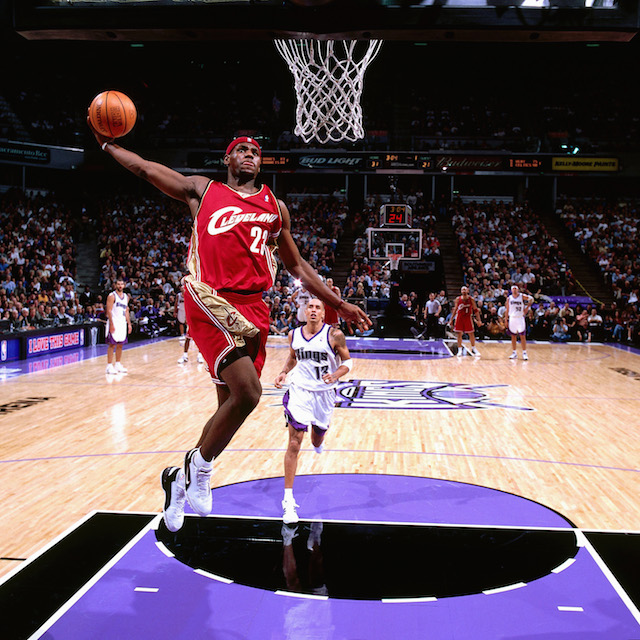It’s hard to imagine now, but at the time, a lot of people were underwhelmed.
Maybe it was his team’s record. The Cleveland Cavaliers earned the No. 1 pick in the 2003 NBA Draft by being one of the NBA’s worst teams in 2002-03. The addition of a single, hyper-talented 18-year-old rookie made them much better, no doubt, but the ’03-04 Cavs still weren’t very good. They started that season 0-5, and ended it 35-47.
Or maybe it was the competition from his fellow rookies. Carmelo had comparable numbers on a (slightly) better team in Denver. D-Wade down in Miami wasn’t far behind. Among such a talented draft class, did the kid from Akron really look that much better than his fresh-faced peers?
But if we’re being real, this was mostly about expectations. About hype, as fed by this publication and many others, in the months and years leading up to his NBA debut. We spent so much time explaining how great LeBron James was going to be, his actual greatness seemed somehow insufficient. Mere greatness wasn’t enough for some. He was still human, after all.
Looking back on it 13 years later, LeBron’s Rookie of the Year campaign is best appreciated for what it promised—or in some cases only alluded to. Much of what we knew from his remarkable high school career was confirmed immediately: That he could score, often and efficiently, as witnessed by 25 points on 12-20 shooting in his NBA debut. That he was big and strong enough to hang in a man’s league, as evidenced by double-digit rebound totals in two of his first four games. That his court vision and selflessness would set him apart: 9 assists in his first NBA game, and a season average of nearly 6 per game on one of the League’s worst-shooting teams. And that he was durable, averaging just shy of 40 minutes per game.

Even in his (relative) weaknesses, there was promise. He could shoot a higher percentage, rebound at a higher rate, get to the line more often—he could, and he would, do all of these things soon enough. And maybe that, too, was down to expectation: the sense that, for all the hype, he should’ve been a finished product as a rookie. He wasn’t, of course. Not even the great ones are.
Nicknames asides, the breadth of LeBron’s rookie year signified itself not as a coronation, but as a new beginning, for the franchise, and for the League itself. It was only fitting that the Cavs opened the 2003-04 season with new uniforms, ditching the powder blue, orange and black color scheme for a return to their classic “wine and gold.” It was perhaps a presumptuous switch, opting for colors that so boldly hinted at wealth, success and royalty. Presumptuous, or maybe just prophetic.
It took a lot to justify all of that, of course—both the Cavs’ optimism and LeBron’s hype. It took years of franchise improvement, of going from mediocre to good to great—but not quite good enough. It took LeBron leaving, and then coming back home. It took two titles in Miami, and a run of six straight NBA Finals appearances, and (twice) outplaying the League MVP when it mattered most. It took the most Vine’d (RIP) chasedown block in the history of civilization, and more than a little help from his friends. The overblown hype, the absurd expectations—all of it is justified now.
—
Action photo via Getty Images